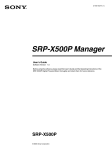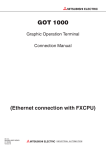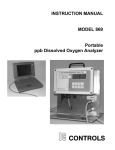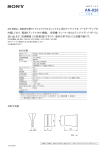Download Sony SRP-X500P User's Manual
Transcript
2-190-706-13 (1) Digital Powered Mixer Operating Instructions Before operating the unit, please read this manual thoroughly and retain it for future reference. SRP-X500P © 2004 Sony Corporation Important Safety Instructions • • • • • • • Read these instructions. Keep these instructions. Heed all warnings. Follow all instructions. Do not use this apparatus near water. Clean only with dry cloth. Do not block any ventilation openings. Install in accordance with the manufacturer’s instructions. • Do not install near any heat sources such as radiators, heat registers, stoves, or other apparatus (including amplifiers) that produce heat. • Do not defeat the safety purpose of the polarized or grounding-type plug. A polarized plug has two blades with one wider than the other. A grounding-type plug has two blades and a third grounding prong. The wide blade or the third prong is provided for your safety. If the provided plug does not fit into your outlet, consult an electrician for replacement of the obsolete outlet. • Protect the power cord from being walked on or pinched particularly at plugs, convenience receptacles, and the point where they exit from the apparatus. • Only use attachments/accessories specified by the manufacturer. • Use only with the cart, stand, tripod, bracket, or table specified by the manufacturer, or sold with the apparatus. When a cart is used, use caution when moving the cart/apparatus combination to avoid injury from tip-over. • Unplug this apparatus during lightning storms or when unused for long periods of time. Refer all servicing to qualified service personnel. Servicing is required when the apparatus has been damaged in any way, such as power-supply cord or plug is damaged, liquid has been spilled or objects have fallen into the apparatus, the apparatus has been exposed to rain or moisture, does not operate normally, or has been dropped. Owner’s Record The model and serial numbers are located at the side of the unit. Record the serial number in the space provided below. Refer to them whenever you call upon your Sony dealer regarding this product. Model No. SRP-X500P Serial No. WARNING To prevent fire or shock hazard, do not expose the unit to rain or moisture. 2 To avoid electrical shock, do not open the cabinet. Refer servicing to qualified personnel only. THIS APPARATUS MUST BE EARTHED. This symbol is intended to alert the user to the presence of uninsulated “dangerous voltage” within the product’s enclosure that may be of sufficient magnitude to constitute a risk of electric shock to persons. This symbol is intended to alert the user to the presence of important operating and maintenance (servicing) instructions in the literature accompanying the appliance. WARNING When installing the unit, incorporate a readily accessible disconnect device in the fixed wiring, or connect the power cord to socket-outlet which must be provided near the unit and easily accessible. If a fault should occur during operation of the unit, operate the disconnect device to switch the power supply off, or disconnect the power cord. CAUTION This apparatus shall not be exposed to dripping or splashing and no objects filled with liquid, such as vases, shall be placed on the apparatus. CAUTION The unit is not disconnected from the AC power source (mains) as long as it is connected to the wall outlet, even if the unit itself has been turned off. For the customers in the U.S.A. This equipment has been tested and found to comply with the limits for a Class B digital device, pursuant to Part 15 of the FCC Rules. These limits are designed to provide reasonable protection against harmful interference in a residential installation. This equipment generates, uses, and can radiate radio frequency energy and, if not installed and used in accordance with the instructions, may cause harmful interference to radio communications. However, there is no guarantee that interference will not occur in a particular installation. If this equipment does cause harmful interference to radio or television reception, which can be determined by turning the equipment off and on, the user is encouraged to try to correct the interference by one or more of the following measures: – Reorient or relocate the receiving antenna. – Increase the separation between the equipment and receiver. – Connect the equipment into an outlet on a circuit different from that to which the receiver is connected. – Consult the dealer or an experienced radio/TV technician for help. You are cautioned that any changes or modifications not expressly approved in this manual could void your authority to operate this equipment. If you have any questions about this product, you may call; Sony Customer Information Service Center 1-800-222-7669 or http://www.sony.com/ Declaration of Conformity Trade Name SONY Model: SRP-X500P Responsible Party: Sony Electronics Inc. Address: 16450 W. Bernardo Dr, San Diego, CA 92127 U.S.A. Telephone Number: 858-942-2230 For the customers in Europe This product with the CE marking complies with both the EMC Directive (89/336/EEC) and the Low Voltage Directive (73/23/EEC) issued by the Commission of the European Community. Compliance with these directives implies conformity to the following European standards: • EN60065: Product Safety • EN55103-1: Electromagnetic Interference (Emission) • EN55103-2: Electromagnetic Susceptibility (Immunity) This product is intended for use in the following Electromagnetic Environment(s): E1 (residential), E2 (commercial and light industrial), E3 (urban outdoors), and E4 (controlled EMC environment, ex. TV studio). 3 Table of Contents Overview.................................................................................6 Features ...................................................................................... 6 The SRP-X500P manuals........................................................... 6 Using the supplied CD-ROM..................................................... 6 Operating Conditions............................................................ 7 Precautions ............................................................................ 8 Location and Function of Parts............................................9 Front panel ................................................................................. 9 Rear panel ................................................................................ 12 Installation............................................................................ 14 Installing the tuner units........................................................... 14 About blank panels................................................................... 14 Rack mounting ......................................................................... 15 WRU-806 channel setting ........................................................ 15 System Configurations and Speaker Connections .......... 17 Sample configuration using the SRP-X500P factory-settings . 17 Sample system configuration with a custom operation panel and environmental equipment connected .............................. 18 Speaker connection .................................................................. 19 Selection of system type .......................................................... 19 To suppress howling ................................................................ 22 Controls................................................................................ 23 PROJECTOR CONTROL RS-232C connector....................... 23 PROJECTOR CONTROL CONTROL S IN/OUT connectors 24 REMOTE RS-232C connector................................................. 24 REMOTE PARALLEL connector ........................................... 24 Example of a custom-made operation panel connection to the REMOTE PARALLEL connector.................................. 25 Programming a remote commander......................................... 28 Appendix .............................................................................. 29 Block diagram .......................................................................... 29 Specifications ...................................................................... 30 System ...................................................................................... 30 Audio input connectors ............................................................ 30 Audio output connectors .......................................................... 30 Video input connectors ............................................................ 30 Video output connectors .......................................................... 30 Remote connectors ................................................................... 31 Others ....................................................................................... 31 General ..................................................................................... 31 Dimensions............................................................................... 32 4 Connector specifications .......................................................... 32 Troubleshooting .................................................................. 35 5 Overview Features The SRP-X500P is a versatile powered mixer which incorporates an audio mixer, RGB/video switcher, processor, and power amplifier into a 3U-rack-size unit. external personal computer or system controller to control the SRP-X500P. • REMOTE PARALLEL connector Input signal selection, volume control and scene control of the SRP-X500P can be performed via the input pins. Through the output pins, remote control of the environmental equipment such as a screen and lighting equipment, and the status display of the SRP-X500P can be carried out. Installation of up to two tuner units 9 preset AV system type settings By setting the SYSTEM TYPE selector, the SRP-X500P supports various AV system comfigurations. To enable the use of wireless microphones, the tuner slots of the SRP-X500P allow the installation of up to two WRU-806 units (not supplied) or the URX-M1 Tuner Units that come with the UWP-X1/X2 (not supplied). Projector control The PROJECTOR CONTROL RS-232C connector or the CONTROL S IN/OUT connectors can be used to change the power status of a Sony projector or plasma display to on or to standby, and to select the input signal. Built-in digital mixer The SRP-X500P can be mounted into an EIA-standard 19inch rack (with a 3U-height). Setting up the SRP-X500P using the supplied program The digital mixer features A/D and D/A converters with a 24-bit/48-kHz sampling rate and a high-performance DSP. In addition to regular audio mixer features, the SRPX500P offers such digitally enabled functions as a feedback reducer comprising an independent channel and automatic gain control (AGC). The CD-ROM that comes with the SRP-X500P contains the SRP-X500P Manager program for setting the parameters including AGC (automatic gain control), routing, and equalizer to allow you fine parameter settings. Various audio input/output connectors The two following manuals are supplied with the SRPX500P: • Operating Instructions (provided on the supplied CDROM) • User’s Guide (provided on the supplied CD-ROM) Four microphone inputs and two stereo line inputs can be freely assigned to four output systems. Compatibility with composite/RGB/ component signals The SRP-X500P is equipped with three composite inputs and two RGB/component inputs. These inputs eliminate the need for a separate RGB switcher or video switcher, resulting in a simplified system configuration. The SRPX500P supports high-resolution component signals such as 480p and 1080i, and also SXGA (1280 × 1024 pixels) for RGB. Built-in digital amplifiers 90 W + 90 W + 50 W + 50 W (8Ω or 4Ω) power amplifiers are incorporated. The SRP-X500P also supports 60 W high-impedance speakers (70 V LINE, 82Ω). Remote connectors for external devices • RS-232C connectors The REMOTE RS-232C connector allows the use of an 6 Rack mounting Overview The SRP-X500P manuals The Operating Instructions mainly describe SRP-X500P operations. The User’s Guide explains how to set the parameters using the program “SRP-X500P Manager” supplied on the CD-ROM. Using the supplied CD-ROM The CD-ROM contains the following files. SRP-X500P Operating Instructions This is a PDF file containing information on the functions and operations of the SRP-X500P Digital Powered Mixer. SRP-X500P Manager User’s Guide This is a PDF file containing information on the functions and operations of the SRP-X500P Manager. SRP-X500P Manager This is a program for setting the SRP-X500P parameters from a PC. The English and the Simplified Chinese versions are provided. Operating Conditions How to open files The recommended operating environment for using the SRP-X500P Manager is as follows. 1 2 Insert the supplied CD-ROM into the CD-ROM drive, then click “My Computer.” OS Microsoft Windows Millennium Edition Microsoft Windows 2000 Professional Microsoft Windows XP Professional Double-click “SRP-X500P.” The “Documents” folder and the “SRP-X500P Manager” folder appear. To view the SRP-X500P Operating Instructions pdf file Double-click the “HARD” folder under the “Documents” folder, then double-click the pdf file that you want to view. To view the pdf file of User's Guide for the SRPX500P Double-click the “SOFT” folder under the “Documents” folder, then double-click the pdf file that you want to view. Microsoft Windows XP Home edition CPU Celeron 400 MHz or higher RAM 128 MB of RAM or greater Available hard 20 MB of available hard-disk space disk space Notes on use • The PC must be preinstalled with one of the OS listed above. Operation of this software when the OS has been upgraded is not guaranteed. • Operation this software is not guaranteed in every PC, even if the recommended environment is satisfied. To open these PDF files, Adobe Acrobat or Adobe Reader must be installed on your PC. To get Adobe Reader, go to the website of Adobe Systems Incorporated (http://www.adobe.com/). To use the SRP-X500P Manager Install the program to the PC first. For details on the installation procedure, refer to the SRPX500P Manager User’s Guide. Operating Conditions 7 Precautions • The SRP-X500P must be used within a temperature range of 0°C to 40°C (32°F to 104°F). • Operating the SRP-X500P near electrical equipment (motors, transformers, or dimmers) may cause it to be affected by electromagnetic induction. Keep the SRPX500P as far from such equipment as possible. • The presence of the lighting equipment may produce electrical interference over a very wide frequency range. Position the antennas and the wireless microphones to be used with the SRP-X500P so that interference is minimized. • To avoid degradation of the signal-to-noise ratio, do not use the SRP-X500P near sources of electrical noise or in locations subject to vibration, such as the following: − near electrical equipment, such as motors, transformers or dimmers − near air conditioning equipment or places subject to direct air flow from an air conditioner • Clean the surface and the connectors of the SRP-X500P with a dry, soft cloth. Never use thinner, benzene, alcohol or any other chemicals, since these may mar the finish. 8 Precautions Location and Function of Parts Front panel 1 2 3 qk qj 45 6 qh qg qf qd 7 qs qa q; 8 9 (In the figure above, the two blank panels are removed.) A POWER switch Turns the SRP-X500P on and off. With the SRP-X500P Manager software, you can set a parameter that will cause the projector or display monitor connected to the SRP-X500P to turn on or enter standby status when the POWER switch is pressed. The SRP-X500P is factory-set so that turning it on does not turn on the connected projector or display monitor, but when the SRP-X500P is turned off, the connected projector or display monitor enters standby status. For details on setting the parameter to make the connected projector or display monitor turn on or enter standby status when the POWER switch is pressed, refer to “SRPX500P Manager User’s Guide.” B EMG (emergency) indicator Lights up red when an emergency broadcast system connected to the REMOTE PARALLEL connector is activated. The output signals from the SPEAKERS CH terminals and the LINE OUTPUT connectors are cut at this time. C Slots for tuner units (WL1/WL2) Holds up to two optional tuner units (the WRU-806 UHF Synthesizer Tuner Unit (not supplied) or the URX-M1 Tuner Unit included in the Wireless Microphone System UWP-X1/X2 (not supplied)) for using wireless microphones. For details on installing tuner units, see “Installing the tuner units” (page 14). D Remote emitter/sensor Point the optional remote commander towards the emitter/ sensor. An optional programmable remote commander (RMAV3000 series, etc.) can be used to operate the SRPX500P after it has been programmed with the SRP-X500P commands via the remote emitter/sensor. For details, see “Programming a remote commander” (page 28) and refer to the Operating Instructions supplied with the remote commander. E Input level controls Rotate to adjust the input signal level. MIC1/WL1: Adjusts the level of the signal input from the MIC INPUT 1 connector or the tuner unit installed in the WL1 slot. MIC2/WL2: Adjusts the level of the signal input from the MIC INPUT 2 connector or the tuner unit installed in the WL2 slot. Location and Function of Parts 9 MIC 3: Adjusts the level of the signal input from the MIC INPUT 3 connector. MIC 4: Adjusts the level of the signal input from the MIC INPUT 4 connector. LINE: Adjusts the level of the signals input from the LINE IN connectors. AV/RGB: Adjusts the level of the signals input from the AV/RGB INPUT audio connectors, as specified by the J AV/RGB SELECT buttons. I MASTER control Adjusts the output level of the assigned channels. With the SRP-X500P Manager software, you can specify which output channels are controlled by the MASTER control. The MASTER control is factory-set to control the output from the SPEAKERS CH-1 to 4 terminals and the LINE OUTPUT 1/2 connectors. (Note that the output from the LINE OUTPUT 3/4 terminals cannot be controlled.) F Input indicators SIGNAL (signal level) indicators: Light up green when the signal is input from each audio connector. RF (radio frequency) indicators: Light up green when the level of the RF signal input from each tuner unit is satisfactory. AF (audio frequency) indicators: Light up yellow when the signal is input from each tuner unit. J AV RGB SELECT buttons (A to E) Press to select a device connected to the AV/RGB INPUT audio/video connectors. The pressed button lights up green. G SPEAKER OUTPUT indicators PROTECTION (protection circuit) indicator: Lights up red when the protection circuit of the internal power amplifier operates. CLIP (clip) indicators: Light up red when the output level of the internal power amplifier is excessive and the output signal is distorted. 70V LINE (high-impedance speaker connection) indicator: Lights up green when the SPEAKERS CH-3/4 terminals are set to connect high-impedance speakers (70V LINE). VU (volume unit) meters: Uses 5-segment LEDs to indicate the signal output level prior to adjustment by the L SPEAKER OUT controls. Note When the internal protection circuit operates, the signal output is cut to protect the speakers and the SRP-X500P from being damaged. • If any of the following conditions arises, turn off the SRP-X500P and eliminate the cause. − The temperature inside the amplifier exceeds the specified level due to excessive output. − The impedance of the connected speakers is too low. − The ventilation holes (located on both sides of the SRP-X500P) are blocked by dust. − The SPEAKERS terminals are short-circuited. • When the SRP-X500P does not operate normally after eliminating the cause, turn it off and contact the Sony dealer from whom you purchased it. H MASTER MUTING indicator Lights up red when signal output is muted by a command issued from a device connected to the REMOTE PARALLEL or REMOTE RS-232C connector, or by operation of an optional remote commander. 10 Location and Function of Parts K LINE AV/RGB input adjustment section TRIM (input reference level adjustment) controls: Adjust the reference level for the audio signals input from the LINE IN connectors and the AV/RGB INPUT audio connectors. The adjustable range is – 30dBu to 0 dBu. REF. (reference level) indicators: Light up yellow when the audio signal whose level exceeds the reference level is input to the LINE IN connectors and the AV/ RGB INPUT audio connectors. While the audio signal is input, adjust the TRIM controls so that the REF. indicators light up yellow intermittently. L SPEAKER OUT controls Used to attenuate the output level of the internal power amplifier. Before adjusting the speaker output level, use the TRIM controls to specify the reference level for the audio input signals, then use the MASTER control to adjust the overall level. And then use the SPEAKER OUT controls to adjust output level from the SPEAKERS CH-1/2 terminals and CH-3/4 terminals. M PROJECTOR PROTOCOL selector Used to select the protocol corresponding to the model of the projector or display monitor connected to the PROJECTOR CONTROL RS-232C connector or the CONTROL S IN/OUT connectors. (Select position 0 only when setting the projector protocol using the SRP-X500P Manager software.) The setting becomes effective next time the power is turned on. Thus, change the setting while the SRP-X500P is turned off. For details on the selector position and projector and display monitor models, see “PROJECTOR CONTROL RS-232C connector” (page 23) and “PROJECTOR CONTROL CONTROL S IN/OUT connectors” (page 24). Note For control of an LCD Data Projector VPL-PX15, use the CONTROL S connectors instead of the PROJECTOR CONTROL RS-232C connector. N SYSTEM TYPE selector Can be set to positions 1-9, according to the speaker configuration of the AV system being used. (Select position 0 only when setting the system type using the SRP-X500P Manager software.) The setting becomes effective next time the power is turned on. Thus, change the setting while the SRP-X500P is turned off. For details on the various system types, see “Selection of system type” (page 19). O IR OUTPUT MODE (remote programming) button Used to program an SRP-X500P command to an optional remote commander with leaning capability. For details on how to program an optional remote commander, see “Programming a remote commander” (page 28) and refer to the Operating Instruction supplied with the remote commander. P Microphone input adjustment section +48V (48 V DC power supply) ON/OFF switches: Set to ON to supply 48 V DC power to condenser microphones connected to the MIC INPUT 1 to 4 connectors. These switches are factory-set to OFF. Note Before turning these switches, be sure to fully turn down all input level controls and the LINE AV/RGB controls, or turn off the unit. TRIM (microphone input reference level adjustment) controls: Set the reference level for signals input from the MIC INPUT 1 to 4 connectors. The settable range is –60 dBu to –30 dBu. controls so that the REF. indicators light up yellow intermittently. FEED BACK REDUCER (howling suppressor) buttons: Used to turn the howling noise reducing function on or off, and to make settings for the function. The buttons light up green when the function is turned on. For details on the settings, see “To suppress howling” (page 22). Q RS-232C indicator Lights up green when the SRP-X500P and a PC or external controller are communicating via the REMOTE RS-232C connector. R PROJECTOR ON/STANDBY POWER switch Turns on the projector or the display monitor connected to the SRP-X500P or sets the projector or the monitor to standby status. Press the switch while it is lighted up red (i.e., the projector or display monitor is in standby status) to turn the projector or display monitor on. The switch lights up green when the projector or the monitor is turned on. To turn off the projector or the monitor, keep pressing the switch for more than 2 seconds. The switch flashes green while the projector or the monitor cools off, and then lights up red when the projector or monitor enters standby status. Notes • If you turn on the projector or display monitor or change the input setting by operating it directly or by using the remote commander supplied with it, the PROJECTOR ON/STANDBY switch indication and actual status of the projector or display monitor may become unmatched. • If you attempt to turn on the projector or display monitor while it is cooling off, it may not respond. Turn it on again after the projector or display monitor finishes cooling off and enters standby status. Notes • A reference level cannot be set for signal input from tuner units installed to the SRP-X500P. • The TRIM controls treat their adjustable signal range as two areas (one is between –60 dBu and –50 dBu and another is between –49 dBu and –30 dBu) and because of this, sound dropouts may be observed while adjusting the reference level for the signal input from the microphones. However, this is not a malfunction. REF. (reference level) indicators: Light up yellow when the audio signal whose level exceeds the reference level is input to the MIC INPUT 1 to 4 connectors. While the audio signal is input, adjust the TRIM Location and Function of Parts 11 Rear panel 1 2 3 4 5 1 6 7 3 # 3 # 3 # 3 # 3 # qf qd qs qa 9 8 A ANT IN a/b connectors (BNC type) Connect antennas for the tuner unit installed in the SRPX500P. Only the supplied antennas or the UHF Antenna AN-820 (not supplied) can be used. B PROJECTOR CONTROL CONTROL S IN/OUT connectors (stereo mini jack) Used to control the LCD Data Projector VPL-PX15 exclusively. Notes For details on the function of this connector, see “PROJECTOR CONTROL CONTROL S IN/OUT connectors” (page 24). • If the antenna is not installed correctly, faulty reception may result, including intermittent sound. The performance of the antenna should be fully confirmed prior to installation, especially if the location does not allow the antenna to be easily repositioned after installation. • Use a coaxial cable with impedance of 50Ω to connect the antenna. In the case of a 5D-FB cable, the maximum length is approximately 50 meters. Do not use 5C-2V or other cables with an impedance of 75Ω, as such cables have a short maximum cable length that is about half that of a 5D-FB and may be a source of technical problems. • Do not install the supplied antennas in a place surrounded by metal object, as this may cause the reception failure. If noise occurs Depending on the installation location, it may be impossible to use a specific channel due to external noise or electromagnetic interference. If this happens, with the wireless microphone or the transmitter turned off, select a channel on the tuner unit that does not light up the RF indicator (i.e., a channel that is not adversely affected by noise or interference). Then set the wireless microphone or the transmitter to the same channel as the tuner unit. 12 0 Location and Function of Parts C PROJECTOR CONTROL RS-232C connector (Dsub, 9-pin, male) Used for the control of a projector or display monitor with an RS-232C connector connected to the F OUTPUT COMPONENT/RGB or OUTPUT VIDEO connector of the SRP-X500P. D REMOTE PARALLEL connector (D-sub, 25-pin, female) This connector consists of 10 input pins and 10 output pins. The SRP-X500P can be controlled by a switch or volume controller connected to the input pins. Connecting these pins to an emergency broadcast system allows the SRP-X500P’s audio output to be cut off during an emergency broadcast. An LED can be connected to the output pins to indicate the unit’s status. The following devices can be connected to this connector. Input pins Connectable device Remarks Switch - Volume With 10 kΩ , B-curve Emergency broadcast Connected via relay system K AV/RGB INPUT audio connectors (A to E) (phono jack) Connect to the audio output connectors of the devices whose video output is connected to the N AV/RGB INPUT video connectors on the SRP-X500P. When connecting a device, be sure that each output connector on the device is connected to the AV/RGB INPUT video and audio connector on the SRP-X500P with the corresponding letter (A to E). Output pins Connectable device Remarks LED 24 V DC or less, 40 mA or less Relay 24 V DC or less, 40 mA or less E REMOTE RS-232C connector (D-sub, 9-pin, male) This is an RS-232C serial connector for remote control. When a PC is connected, parameters can be set using the SRP-X500P Manager software. The SRP-X500P can be controlled from the external controller connected to the REMOTE RS-232C connector. F OUTPUT connector section These connectors output the video signal input from the AV/RGB INPUT video connectors. Signal format conversion is not carried out. COMPONENT/RGB connector (HD D-sub, 15-pin, female): Outputs component or RGB signal. VIDEO connector (phono jack): Outputs composite signal. L LINE IN connectors (phono jack) Connect to the line output connectors of a CD player, MD recorder, etc. M MIC INPUT connectors (1 to 4) (XLR-3-31 type) Connect wired microphones. When wired microphones are connected to the MIC INPUT 1/2 connectors, the input signal from the wireless microphones take priority from the moment the tuner units begin receiving the signal. N AV/RGB INPUT video connectors (A to C: phono jack, D and E: HD D-sub, 15-pin, female) Connect to the video output connectors of the devices whose audio output is connected to the K AV/RGB INPUT audio connectors on the SRP-X500P. When connecting a device, be sure that each output connector on the device is connected to the AV/RGB INPUT video and audio connector on the SRP-X500P with the corresponding letter (A to E). G SPEAKERS CH terminals (1 to 4) (screw terminal) These are the output terminals of the internal power amplifiers. For details on connecting the speakers, see “Speaker connection” on page 19. H CIRCUIT BREAKER button The circuit breaker cuts off the main power when excessive current flows through the AC IN connector. If the circuit breaker trips, press the CIRCUIT BREAKER button to reset the breaker, but do not use the SRP-X500P. Instead, turn it off and contact the Sony dealer from whom you purchased the unit. I AC IN connector Connects the supplied AC power cord. J LINE OUTPUT connectors (1 to 4) (phono jack) Connect to the line input connectors of a power amplifier, CD/MD recorder, etc. The LINE OUTPUT 3/4 connectors are factory-set to function as the REC OUT connectors. Location and Function of Parts 13 that of the tuner unit, or that the battery in the microphone is running down. Installation To remove the tuner unit Pull the latch securing the tuner unit to the side and pull out the tuner unit. Installing the tuner units Up to two WRU-806 UHF Synthesizer Tuner Units (not supplied) or two URX-M1 Tuner Units included in the UWP-X1/X2 (not supplied) can be installed in the SRPX500P. Tuner unit Notes • To prevent the production of noise, be sure to turn the SRP-X500P off before installing or removing the tuner units. • When installing the tuner unit, insert it fully into the tuner slot of the SRP-X500P and secure it with the latch on the slot. • Do not touch the inside of the tuner unit slots. 1 Turn off the SRP-X500P, check the top and bottom sides of the tuner unit, and then insert it into the slot. Tuner unit Latch About blank panels Two blank panels (large and small) are attached to the front of the SRP-X500P. Remove both of these panels to perform settings. After completing the settings, reattach the panels to prevent malfunctioning of the unit and to keep the tuner units from falling off the slot. When the input level controls are used Latch 2 Turn on the SRP-X500P and perform the group and channel settings for the tuner unit, following the instructions in “WRU-806 channel setting” (page 15). Make the same group and the channel settings for the wireless microphone used in conjunction with the tuner unit. Blank panel (large) When the input level controls are not used For details on settings of the UWP-X1/X2, refer to the Operating Instructions supplied with the product. 3 Turn on the wireless microphone and check that the tuner unit is receiving a signal from the microphone. While a signal is being properly received from the microphone, the RF indicator on the tuner unit lights up. If the RF indicator does not light up, this means the channel setting for the microphone is different from 14 Installation Blank panel (large) Blank panel (small) Note When removing the blank panels to the SRP-X500P, be sure to start with the small panel. Rack mounting GP button + button CH button – button RF indicator About the rack Use an EIA-standard 19-inch rack with a depth of 450 mm or more. Use four screws of the same diameter as the rack screw holes and with an effective length of 12 mm or more to mount the SRP-X500P into the rack. Rack 1 Turn on the SRP-X500P. 2 Press and hold down the GP button, and press the + or – button to select a group. Each time you press the + or – button, the GP indication changes as shown in the following figure. To change the indication continuously, press and hold down the + or – button. GP CH GP CH Screws (+B M5 X 12) SRP-X500P Screws (+B M5 X 12) Display example of WRU-806B (CE62 model) Note When mounting the SRP-X500P into a rack, be sure it is done by 2 people or more. GP CH GP CH WRU-806 channel setting Take the following precautions to prevent interference and noise. • If there is a TV broadcasting station nearby, to avoid possible interference from its broadcasting, do not use that station’s channel. • When simultaneously using two or more tuners, always set the tuners to different channels within the same group (other than group 00). Display example of WRU-806B (U66 model) GP CH GP CH Display example of WRU-806A (AU66 model) The CH indication shows the lowest frequency channel of the selected group. For group 00, however, the channel selected last is displayed. Installation 15 Releasing the buttons automatically cancels the group and channel selection mode, and the currently displayed group is selected. Refer to “Wireless Microphone System Frequency List” supplied with the WRU-806. 3 Press and hold down the CH button, and press the + or – button in 3 seconds to select a channel. Similer to step 2, each time you press the + or – button, the CH indication changes in the order shown in the group and reception channel list. Refer to “Wireless Microphone System Frequency List” supplied with the WRU-806. If you press the + button when the last channel of the selected group is displayed, the first channel of the group will be displayed. Display example of WRU-806B (CE62 model) Selecting the reception channel by frequency Press the + button. This changes the GP/CH indication to a frequency indication. To change a frequency, press the + or – button while keeping the CH button pressed. (A higher or lower frequency will be displayed.) Press the + button again to change the frequency indication to a GP/CH indication. GP CH GP CH Display example of WRU-806B (CE62 model) 4 If the desired channel or frequency is displayed, release the CH button and + or – button. The selected channel is set. To store the selected group and channel Leave the indication unchanged for 1 second. The group and channel set in the procedure explained above are stored in memory. 16 Installation System Configurations and Speaker Connections Sample configuration using the SRP-X500P factory-settings In this configuration, the SRP-X500P can be used without having to change the settings with the supplied SRP-X500P Manager software. AN-820 UHF Antenna or the supplied antenna Projector PROJECTOR CONTROL RS-232C INPUT AN-820 UHF Antenna or the supplied antenna Wireless microphone Transmitter Transmitter LINE OUT Document camera PC VIDEO OUT Front speaker (L) Front speaker (R) Wireless microphone RGB OUT 3 # 3 # 3 # 3 # 3 # Table-top microphone, etc. VIDEO OUT LINE OUT VCR , DVD player, etc. LINE OUT To power source MD recorder High-impedance speakers RGB OUT Programmable remote commander LINE IN PC LINE OUT • The configuration above uses two WRU-806 UHF Synthesizer Tuner Units or two URX-M1 Tuner Units included in the UWP-X1/X2. • When an electric condenser microphone is connected to the MIC INPUT 3 or 4 connector, set the +48V ON/OFF switch for the respective connector to ON. System Configurations and Speaker Connections 17 Sample system configuration with a custom operation panel and environmental equipment connected In this configuration, the SRP-X500P can be controlled by a custom operation panel or an external system controller. AN-820 UHF Antenna or the supplied antenna Projector Transmitter PROJECTOR CONTROL RS-232C INPUT Wireless microphone Custom operation panel AN-820 UHF Antenna or the supplied antenna Front speaker (L) Operation terminal Document camera VIDEO OUT External system controller 3 # 3 # 3 # 3 # Wireless microphone Transmitter 3 # Table-top microphone, etc. VIDEO OUT LINE OUT VCR , DVD player, etc. RGB OUT Programmable remote commander PC LINE OUT Front speaker (R) To power source LINE OUT LINE IN I/F BOX MD recorder Screen I/F BOX RGB OUT PC Rear speaker (L) Curtain LINE OUT Rear speaker (R) I/F BOX Lighting equipment • The SRP-X500P and the connected devices can be controlled by commands sent by an external system controller to the SRP-X500P. (System controller software is required.) • The configuration above uses two WRU-806 UHF Synthesizer Tuner Units or two URX-M1 Tuner Units included in the UWP-X1/X2. • When an electret condenser microphone is connected to the MIC INPUT 3 or 4 connector, set the +48V ON/OFF switch for the applicable connector to ON. • When controlling the environment equipment such as screen, curtains, and lighting equipment through the REMOTE PARALLEL connector, interface boxes are required. For details on the use of a custom operation panel and interface boxes, see “REMOTE PARALLEL connector” (page 24). 18 System Configurations and Speaker Connections To connect low-impedance speakers to the SPEAKERS CH-3/4 terminals Speaker connection Only speakers with low impedance (4 to 16Ω) can be connected to the SPEAKERS CH-1/2 terminals. Speakers of high or low impedance can be connected to the SPEAKERS CH-3/4 terminals by setting the SYSTEM TYPE selector. The SPEAKERS CH-3/4 terminals are factory-set so that the speakers with high impedance can be connected. Set the SYSTEM TYPE selector to “2,” “5,” “6,” “7,” “8,” or “9.” Or, set the SYSTEM TYPE selector to “0” and use the SRP-X500P Manager software to make setting. Connect the speakers as shown in the following figure. To connect high-impedance speakers to the SPEAKERS CH-3/4 terminals Set the SYSTEM TYPE selector to “1” or “4.” Or, set the SYSTEM TYPE selector to “0” and use the SRP-X500P Manager software to make setting. When one of the settings above is made, the output from the SPEAKERS CH-3/4 terminals becomes monaural. Connect the (+) terminal of the speaker to the (+) (red) SPEAKERS CH-3 terminal and connect the (–) terminal of the speaker to the (+) (red) SPEAKERS CH-4 terminal. Selection of system type The following table shows the number of speakers that can be connected when the SPEAKERS CH-3/4 terminals are set for high-impedance speakers. Speaker impedance Power applied to each speaker Number of connectable speakers 1 kΩ 5W 12 3.3 kΩ 1.5 W 40 10 kΩ 0.5 W 120 From 9 preset patterns provided on the SRP-X500P, it is possible to choose the speaker system type that corresponds with the AV system being used. The preset pattern can be selected by using the SYSTEM TYPE selector (1 to 9). Each preset pattern includes the following: • MIC INPUT Low Cut Filter • ROUTING • DELAY • INPUT MUTING • OUTPUT MUTING • OUTPUT LINK • COMPRESSOR • SPEAKERS CH-3/4 terminal status (70V LINE or Lo. Imp) • REMOTE FADER Details on each preset pattern are given below: SYSTEM TYPE 1 For a speaker system consisting of a pair of front speakers and high-impedance ceiling speakers (70V LINE). System Configurations and Speaker Connections 19 SPEAKERS MIC IN Audio from the AV components is output from the front speakers in stereo, and audio from the microphones is output from the ceiling speakers to enhance clarity. • Input/output SPEAKERS SP 2 SP 3 SP 4 CH-1 CH-2 CH-3 CH-4 ON/OFF OFF OFF ON ON ON ON ON ON LEVEL 0dB 0dB 0dB 0dB 0dB 0dB 0dB 0dB LINE IN L ON/OFF ON OFF OFF OFF ON OFF OFF OFF LEVEL 0dB 0dB 0dB 0dB 0dB 0dB 0dB LINE IN R ON/OFF OFF ON OFF OFF OFF ON OFF OFF LEVEL 0dB 0dB 0dB 0dB 0dB 0dB 0dB AV/RGB IN L ON/OFF ON OFF OFF OFF ON OFF ON OFF LEVEL 0dB 0dB 0dB 0dB 0dB 0dB 0dB 0dB AV/RGB IN R ON/OFF OFF ON OFF OFF OFF ON OFF ON LEVEL 0dB 0dB 0dB 0dB 0dB 0dB 0dB 0dB 0dB 0dB • Delay Distance compensation is not set. LINE OUT SP 1 SP 2 70V CH-1 CH-2 CH-3 LINE (SP 3-4) CH-4 ON/OFF OFF OFF ON ON ON ON ON LEVEL 0dB 0dB 0dB 0dB 0dB 0dB 0dB LINE IN L ON/OFF ON OFF OFF ON OFF OFF OFF LEVEL 0dB 0dB 0dB 0dB 0dB 0dB 0dB LINE IN R ON/OFF OFF ON OFF OFF ON OFF OFF LEVEL 0dB 0dB 0dB 0dB 0dB 0dB 0dB AV/RGB IN L ON/OFF ON OFF OFF ON OFF ON OFF LEVEL 0dB 0dB 0dB 0dB 0dB 0dB 0dB AV/RGB IN R ON/OFF OFF ON OFF OFF ON OFF ON LEVEL 0dB 0dB 0dB 0dB 0dB 0dB 0dB MIC IN LINE OUT SP 1 SYSTEM TYPE 3 For a speaker system consisting of a pair of front speakers only. • Delay Distance compensation is not set. SYSTEM TYPE 2 Audio from the AV components and the microphones is output from the front speakers. For a speaker system consisting of a pair of front speakers and low-impedance ceiling speakers (Lo. imp). • Input/output SPEAKERS LINE OUT SP 1 SP 2 SP 3 SP 4 CH-1 CH-2 MIC IN - - ON ON ON ON LEVEL 0dB 0dB - - 0dB 0dB 0dB 0dB LINE IN ON/OFF ON L LEVEL 0dB OFF - - ON OFF OFF OFF 0dB - - 0dB 0dB 0dB 0dB ON - - OFF ON OFF OFF 0dB - - 0dB 0dB 0dB 0dB AV/RGB ON/OFF ON IN L LEVEL 0dB • Input/output 20 System Configurations and Speaker Connections CH-4 ON LINE IN ON/OFF OFF R LEVEL 0dB Audio from the AV components is output from the front speakers in stereo, and audio from the microphones is output from the ceiling speakers to prevent howling. CH-3 ON/OFF ON AV/RGB ON/OFF OFF IN R LEVEL 0dB OFF - - ON OFF ON OFF 0dB - - 0dB 0dB 0dB 0dB ON - - OFF ON OFF ON 0dB - - 0dB 0dB 0dB 0dB • Delay Distance compensation is not set. SYSTEM TYPE 4 For a speaker system consisting of high-impedance ceiling speakers (70V LINE). Adjust the SPEAKER OUT controls so that the output level from the SPEAKERS CH-1/2 terminals and from the SPEAKERS CH-3/4 terminals is equal to each other. • Input/output SPEAKERS SP 1 MIC IN ON/OFF ON LEVEL Audio from the AV components (monaural) and the microphones is output from the ceiling speakers. LINE OUT SP 2 SP 3 SP 4 CH-1 CH-2 CH-3 CH-4 ON ON ON ON ON ON ON 0dB 0dB 0dB 0dB 0dB 0dB 0dB 0dB LINE IN L ON/OFF ON ON ON ON ON OFF OFF OFF LEVEL -3dB -3dB -3dB 0dB 0dB 0dB 0dB LINE IN R ON/OFF ON ON ON OFF ON OFF OFF LEVEL -3dB -3dB -3dB 0dB 0dB 0dB 0dB AV/RGB IN L ON/OFF ON ON ON ON OFF ON OFF -3dB -3dB -3dB 0dB 0dB 0dB 0dB AV/RGB IN R ON/OFF ON ON ON OFF ON OFF ON LEVEL -3dB -3dB -3dB 0dB 0dB 0dB 0dB LEVEL -3dB -3dB -3dB -3dB ON ON ON • Input/output 70V CH-1 CH-2 CH-3 LINE (SP 3-4) CH-4 • Delay Distance compensation is not set. ON ON SYSTEM TYPE 6 to 9 SPEAKERS SP 1 MIC IN ON/OFF - SP 2 - LINE OUT ON ON ON LEVEL - - 0dB 0dB 0dB 0dB 0dB LINE IN L ON/OFF - - ON ON OFF OFF OFF LEVEL - - -3dB 0dB 0dB 0dB 0dB LINE IN R ON/OFF - - ON OFF ON OFF OFF LEVEL - - -3dB 0dB 0dB 0dB 0dB AV/RGB IN L ON/OFF - - ON ON OFF ON OFF LEVEL - - -3dB 0dB 0dB 0dB 0dB AV/RGB IN R ON/OFF - - ON OFF ON OFF ON LEVEL - - -3dB 0dB 0dB 0dB 0dB For a speaker system consisting of a pair of front speakers and low-impedance satellite speakers (Lo. imp). • Delay Distance compensation is not set. SYSTEM TYPE 5 For a speaker system consisting of low-impedance ceiling speakers (Lo. imp). Audio from both the AV components and the microphones is output from all speakers. • Input/output SPEAKERS SP 1 SP 3 SP 4 CH-1 CH-2 CH-3 CH-4 ON/OFF ON ON ON ON ON ON ON LEVEL 0dB 0dB 0dB 0dB 0dB 0dB 0dB 0dB LINE IN L ON/OFF ON OFF ON OFF ON OFF OFF OFF LEVEL 0dB 0dB 0dB 0dB 0dB 0dB 0dB 0dB LINE IN R ON/OFF OFF ON OFF ON OFF ON OFF OFF LEVEL 0dB 0dB 0dB 0dB 0dB 0dB 0dB 0dB AV/RGB IN L ON/OFF ON OFF ON OFF ON OFF ON OFF LEVEL 0dB 0dB 0dB 0dB 0dB 0dB 0dB 0dB AV/RGB IN R ON/OFF OFF ON OFF ON OFF ON OFF ON LEVEL 0dB 0dB 0dB 0dB 0dB 0dB 0dB MIC IN Audio from the AV components (monaural) and the microphones is output from the ceiling speakers. LINE OUT SP 2 0dB ON System Configurations and Speaker Connections 21 • Delay SYSTEM TYPE 6: Select when no compensation is necessary. SYSTEM TYPE 7: Select when the distance between the front speakers and the satellite speakers are 5 meters to 8 meters (16.7 feet to 26.7 feet). SYSTEM TYPE 8: Select when the distance between the front speakers and the satellite speakers are 8 meters to 11 meters (26.7 feet to 36.7 feet). SYSTEM TYPE 9: Select when the distance between the front speakers and the satellite speakers are 11 meters to 14 meters (36.7 feet to 46.7 feet). SPEAKERS SYSTEM TYPE 6 ON/OFF TIME SYSTEM TYPE 7 ON/OFF TIME SYSTEM TYPE 8 ON/OFF TIME SYSTEM TYPE 9 ON/OFF TIME SP 1 SP 2 SP 3 SP 4 OFF OFF OFF OFF By using the FEED BACK REDUCER buttons, you can suppress howling by detecting the frequency bands in which the howling may occur, and then reducing the gain of those bands through the 5-band equalizer. To detect the frequency bands in which howling may occur in order to suppress howling Make settings on the microphone and the SRP-X500P to suppress howling more effectively. 1 Set the reference level for the microphone. 0ms 0ms 0ms 0ms OFF OFF ON ON 0ms 0ms 34.6ms 34.6ms OFF OFF ON ON 0ms 0ms 43.3ms 43.3ms Note OFF OFF ON ON 0ms 0ms 52.0ms 52.0ms When you use a wireless microphone, adjust the attenuator on the microphone instead of the TRIM control. Details on the contents of SYSTEM TYPE preset pattern settings • MIC INPUT Low Cut Filter (common to all SYSTEM TYPE preset patterns) Default setting: ON Cutoff frequency: 100 Hz, –12 dB/oct • INPUT MUTING (common to all SYSTEM TYPE preset patterns) Default setting: OFF • OUTPUT LINK In the AV system incorporating stereo speakers, the level of the L channel and the R channel links and the ouput level of the L and R channels is equal to each other. • COMPRESSOR (common to all SYSTEM TYPE preset patterns) FUNCTION ON / OFF ON THRESHOLD 10dB RATIO ∞:1 ATTACK 0.47ms RELEASE 100ms • REMOTE FADER Depends on the SYSTEM TYPE preset patterns. For details, refer to SRP-X500P Manager User’s Guide. To change the preset settings, set the SYSTEM TYPE selector to “0,” and make each setting on the SRP-X500P Manager program. 22 To suppress howling System Configurations and Speaker Connections While talking on the microphone in a normal voice, adjust the TRIM control so that the REF. indicator lights intermittently. 2 Adjust the volume on the SRP-X500P. Set the input level control and the MASTER control to 0 dB position. 3 Set up the microphone. Place the microphone where it is used and adjust the direction. 4 Adjust the speaker output. Turn up the SPEAKER OUT control on the SRPX500P slowly until the speaker output reaches the level to be heard from anywhere within the place. Be sure to turn down the SPEAKER OUT control whose corresponding speaker output is not used fully to –∞ dB. 5 Perform the howling suppression. Keep pressing the FEED BACK REDUCER button on the SRP-X500P for the corresponding MIC INPUT connector for 2 seconds or more. The button indicator flashes as the SRP-X500P scans the frequency bands. When the button indicator stops flashing and lights up, howling suppression is completed. Notes • While the SRP-X500P is scanning the frequency bands, the sound similar to howling may be output. If the output sound is too loud, press the FEED BACK REDUCER button to cancel the procedure, turn down the SPEAKER OUT control, then try again. • Do not make a noise while the SRP-X500P is scanning the frequency bands, as this may cause error in detection. • When you use the AGC (automatic gain control) function, do the setting by using the SRP-X500P Manager software before performing the procedure above. Controls This section explains how to use the control connectors on the SRP-X500P and how to program an optional programmable remote commander with the functions of the SRP-X500P. PROJECTOR CONTROL RS-232C connector The PROJECTOR CONTROL RS-232C connector can be used to control a projector or display monitor equipped with an RS-232C connector. When the SRP-X500P is connected to a projector or monitor through the PROJECTOR CONTROL RS-232C connector, the power status (on or standby) and input signal selection of the projector or monitor are linked to those of the SRP-X500P. Set the PROJECTOR PROTOCOL selector in accordance with the model of the projector or monitor, as indicated in the following table. The format of the video signal output to the COMPONENT/RGB connector is factory-set to RGB format. To change the setting, refer to the SRP-X500P Manager User’s Guide. Product model PROJECTOR PROTOCOL selector setting RGB input connector on the projector or monitor VPL-CX85/80 1 INPUT A VPL-PX35/40 2 INPUT D VPL-FX51/50 3 INPUT A VPL-PX11 4 INPUT A VPL-PX32/31 5 INPUT A FWD-50PX1 6 INPUT 1 PFM-42X1/V1 7 INPUT 1 PFM-42B2/B1 8 INPUT 1 PFM-50C1 9 INPUT A Not applicable B-F - Notes • Use the cable whose specifications are matched with the projector or monitor to connect the PROJECTOR CONTROL RS-232C connector on the SRP-X500P with the RS-232C connector on the projector or monitor. • When controlling the projector from the SRP-X500P, be sure to turn off the Smart APA function and Auto Input Search function on the projector. • If the projector or a display monitor is not included in the table above, set the PROJECTOR PROTOCOL selector Controls 23 to “0” and use the SRP-X500P Manager software to make settings. • For control of an LCD Data Projector VPL-PX15, use the CONTROL S connectors instead of the PROJECTOR CONTROL RS-232C connector. For details, see “PROJECTOR CONTROL CONTROL S IN/OUT connectors” (page 24). PROJECTOR CONTROL CONTROL S IN/OUT connectors These connectors are for the control of the VPL-PX15 LCD Data Projector. In order to control the VPL-PX15 with the SRP-X500P, set the PROJECTOR PROTOCOL selector as described in the following table. Product model PROJECTOR PROTOCOL SELECTOR setting RGB input connector on the projector VPL-PX15 A INPUT A When the SRP-X500P is connected to the projector through the PROJECTOR CONTROL CONTROL S IN/ OUT connectors, the power status (on or standby) and input signal selection on the projector are linked with those on the SRP-X500P. Also, when a wired remote commander supplied with a projector is connected to the CONTROL S IN connector on the SRP-X500P, the projector settings can be performed on the SRP-X500P. Connect the projector and the projector’s remote commander to the SRP-X500P as shown below. Remote commander Projector PROJECTOR CONTROL CONTROL S IN/OUT connectors. Note that control of the projector by the SRP-X500P takes priority over control by the remote commander. • The following restrictions apply when a projector is controlled by the SRP-X500P via the PROJECTOR CONTROL CONTROL S IN/OUT connectors. − Video signals input from the INPUT VIDEO A/B/C connectors are output to the OUTPUT VIDEO connector in composite format only. − Video signals input from the COMPONENT/RGB D/ E connectors are output to the OUTPUT COMPONENT/RGB connector in either RGB or component format. Be sure to change the input signal format setting on the projector to match the format of the signal output from the SRP-X500P. − When “OTHER TERMINAL” is selected using the SRP-X500P Manager software, the signal is automatically input to the INPUT B connector on the projector or the monitor. REMOTE RS-232C connector A PC installed with the SRP-X500P Manager software can be connected to the REMOTE RS-232C connector to make SRP-X500P settings from the PC. This connector can also be used to connect an external system controller to allow control of the SRP-X500P. The specifications and the communication format for this connector are as follows: Specifications Connector type: D-sub 9-pin, male, inch screw type Electric specifications: Conforms to RS-232C standards Recommended cable: Multi-core shielded cable for data communications Cable length: 15 meters (50 feet) or less Communication format Baud rate: 38400 bps Bit length: 8 bits Stop bit: 1 bit Parity: odd Note Notes • To supply power to the remote commander from the SRP-X500P, use a stereo mini-plug cord to connect the remote commander to the SRP-X500P. When batteries are used to operate the remote commander, use a miniplug cord to connect the remote commander to the SRPX500P. • When the projector’s wired remote commander is connected to the PROJECTOR CONTROL CONTROL S IN connector as illustrated above, the remote sensor on the projector does not function and all commands from the remote commander are transmitted through the 24 Controls Use an RS-232C cross cable to connect the SRP-X500P with a PC. REMOTE PARALLEL connector By connecting a simple circuit such as a switch or volume controller to the REMOTE PARALLEL connector, the SRP-X500P can be controlled remotely. The specifications for this connector are as follows: Specifications Connector type: D-sub 25-pin, female Recommended cable: Multi-core shielded cable for data communications Cable length: 50 meters (166 feet) or less Example of a circuit connection to the output pins of the REMOTE PARALLEL connector Examples of a circuit connection to the input pins of the REMOTE PARALLEL connector Output pins (No.15 to 24) B-curve variable resistor GND pins (No. 1, 12 to 14, 25) Input pins (No.2 to 11) GND pins (No. 1, 12 to 14, 25) Input pins (No. 2 to 11) GND pins (No.1, 12 to 14, 25) By making a contact, the following control can be performed by an external controller: • Input signal selection for the AV/RGB INPUT (video and audio) connectors • Muting • Scene recall • Volume control (turning the master volume up or down) • Turning on or changing to standby of the projector or the monitor • Muting via control from an emergency broadcast system The trigger for turning on each pin of the REMOTE PARALLEL connector can be selected from the following: • Status of the AV/RGB SELECT buttons • Turning on the MASTER MUTING indicator • The status of scene recall function • Command to turn on or change to standby status the projector or the monitor • Status of the MASTER control and REMOTE FADER on the SRP-X500P Manager (maximum/minimum/ muted) • Muting via control from an emergency broadcast system The trigger for each pin can be selected in the REMOTE PARALLEL section of the REMOTE PARALLEL/PROJECTOR CONTROL screen of the SRP-X500P Manager software. Notes • Do not apply a reverse voltage across the output pins. • Do not connect the shield of the remote wire or the ground wire to a relay table, etc. This can cause the device to malfunction and noise. • Keep the remote wire away from dimmers or motors. Example of a custom-made operation panel connection to the REMOTE PARALLEL connector The SRP-X500P is factory set to connect a custom-made operation panel with the following buttons: Controls 25 START button Press to turn on the projector or monitor, lower the screen, close the curtains, and dim the lights as preparation for the start of a presentation. STOP button Press to change the projector or monitor to standby status, raise the screen, open the curtains, and turn on the lights for the ending of a presentation. Selector buttons Press to select one of the devices connected to the AV/ RGB INPUT video/audio connectors. MASTER UP button Turns up the master volume. MASTER DOWN button Turns down the master volume. EMG Turns off all audio output when the SRP-X500P receives a signal from the emergency broadcasting system. 26 Controls Pin No. Function Pin name 1 GND GND 2 INPUT 1 Selects the DVD Player. DVD player selection button 3 INPUT 2 Selects the VCR. VCR selection button 4 INPUT 3 Selects the cassette deck. Cassette deck selection button 5 INPUT 4 Selects PC 1. PC 1 selection button 6 INPUT 5 Selects PC 2. PC 2 selection button 7 INPUT 6 Turns up the master volume. Turning up the master volume 8 INPUT 7 Turns down the master volume. Turning down the master volume 9 INPUT 8 START START button 10 INPUT 9 STOP STOP button 11 INPUT 10 EMG EMG signal input 12 GND GND 13 GND GND 14 GND GND 15 OUTPUT 1 DVD player selection tally signal DVD player selection LED 16 OUTPUT 2 VCR selection tally signal VCR selection LED 17 OUTPUT 3 Cassette deck selection tally signal Cassette deck selection LED 18 OUTPUT 4 PC 1 selection tally signal PC 1 selection LED 19 OUTPUT 5 PC 2 selection tally signal PC 2 selection LED 20 OUTPUT 6 Master volume maximum tally signal Master volume maximum LED 21 OUTPUT 7 Master volume minimum tally signal Master volume minimum LED Lowers the screen, closes the curtains, 22 OUTPUT 8 23 OUTPUT 9 24 OUTPUT 10 EMG tally signal 25 GND GND 40 mA or more 24 V DC or less and dims the light. Raises the screen, opens the curtains, and turns on the light. Screen interface box Curtains interface box Lighting interface box Precautions on the use of interface boxes for environmental equipment (screen, curtains, light) • The output pins of the REMOTE PARALLEL connector provide open-collector output for alternate operation. This means that an ON signal is continuously output from the output pins when environmental equipment is operated, regardless of the operating condition of the equipment. For this reason, stopping a motor during a raising or lowering operation should be carried through the interface box. • When making an interface box, it should be designed so that the screen and curtain operation stops and the Controls 27 lighting equipment turns on when an EMG tally signal is output from pin 24 (OUTPUT 10). 3 Programming a remote commander Commands that control the SRP-X500P functions can be stored to an optional programmable remote commander (RM-AV3000 series, etc.). These functions are the following: • The AV/RGB SELECT buttons • The PROJECTOR POWER switch • The MASTER volume control − Turning up the volume − Turning down the volume − Muting of the volume Place the remote commander so that its top is pointed towards the remote emitter/sensor, and then ready the remote commander for programming commands from the SRP-X500P. 10 cm or less For details on how to program your remote commander, refer to the operation manual that was supplied with it. 1 The button lights up green and the remote emitter/ sensor lights up red when the SRP-X500P is ready to emit commands from the remote emitter/sensor. Note that no audio/video is output from the SRPX500P during this time. 2 Operate the SRP-X500P function to be programmed to the remote commander as follows. To program the function of the AV/RGB SELECT buttons Press the AV/RGB SELECT button to be programmed to the remote commander so that it lights up. To program the function of the PROJECTOR POWER switch Press the PROJECTOR POWER switch so that it lights up. To program the function for turning up the master volume Rotate the MASTER control to the 11 o’clock position so that the MASTER MUTING indicator lights up. To program the function for turning down the master volume Rotate the MASTER control to the 9 o’clock position so that the MASTER MUTING indicator lights up. To program the function for muting the master volume Rotate the MASTER control to the –∞ position so that the MASTER MUTING indicator lights up. 28 Programmable remote commander Keep pressing the IR OUTPUT MODE button for 2 seconds or more. Controls 4 Press the IR OUTPUT MODE button. The button and the remote emitter/sensor flash and command is output from the remote emitter/sensor. 5 When programming has completed, press the IR OUTPUT MODE button again. The button lights up and the command output stops. 6 To program other functions, repeat this procedure from step 2. 7 Keep pressing the IR OUTPUT MODE button for 2 seconds or more. The button and the remote emitter/sensor turn off and the SRP-X500P returns to normal status. After programming has completed, be sure to verify that the command has been correctly programmed or not. If not, repeat the procedure from step 1. E D INPUT COMPONENT/RGB C B A VIDEO INPUT E D C B A INPUT AV/RGB INPUT LINE INPUT 4 MIC INPUT 3 MIC TUNER 2 WL INPUT 2 MIC WL TUNER 1 INPUT 1 MIC ANT IN TRIM TRIM TRIM TRIM TRIM +48V +48V RF +48V RF +48V RGB SELECTOR VIDEO SELECTOR E D B C A AUDIO SELECTOR TRIM TRIM TRIM TRIM TRIM VU METER VU METER VU METER VU METER LCF LCF LCF LCF FR/EQ FR/EQ FR/EQ FR/EQ OUTPUT COMPONENT/RGB OUTPUT VIDEO VU METER VU METER REF. SIGNAL REF. SIGNAL REF. SIGNAL REF. SIGNAL AF REF. SIGNAL AF REF. SIGNAL MUTING MUTING INPUT LEVEL MUTING MUTING INPUT LEVEL MUTING MUTING INPUT LEVEL MUTING INPUT LEVEL MUTING MUTING INPUT LEVEL MUTING MUTING INPUT MIC MIX LEVEL MUTING BUS LEVEL OUTPUT LEVEL INPUT AGC FEMOTE FADER (GUI) INPUT FADER (GUI) INPUT LEVEL MUTING OUTPUT LEVEL MUTING MUTING OUTPUT LEVEL MUTING MUTING OUTPUT LEVEL MUTING MUTING OUTPUT LEVEL MUTING MUTING OUTPUT LEVEL MUTING MUTING OUTPUT LEVEL MUTING FEMOTE FADER (GUI) OUTPUT FADER (GUI) OUTPUT LEVEL VOLUME INPUT LINE OUTPUT BUS ROUTING SPEAKER OUTPUT BUS ROUTING MUTING OUTPUT LEVEL MUTING MUTING OUTPUT LEVEL MUTING EQ COMP VU METER RS-232C IR OUTPUT MODE AV/RGB SELECT PROJECTOR POWER PROJECTOR PROTOCOL DELAY CH1/2 SPEAKER OUT CLIP MAIN CPU 70V LINE Lo Imp. POWER AMP DIGITAL CLIP 70V LINE LCF /BTL SPEAKER OUT CH3/4 VU METER PROTECTION EMG (CONTROLS) IR IN (CONTROLS) IR OUT RERALLEL RS-232C REMOTE OUTPUT CONTROL S INPUT RS-232C CONTROL PROJECTOR OUTPUT 4 LINE OUTPUT 3 LINE OUTPUT 2 LINE OUTPUT 1 LINE OUTPUT 4 SPEAKER OUTPUT 3 SPEAKER OUTPUT 2 SPEAKER OUTPUT 1 SPEAKER Appendix Block diagram Appendix 29 Specifications System Audio Frequency response 20 Hz to 20 kHz ±0.5 dB (with LINE OUTPUT, 1 kHz reference) T.H.D 0.01 % or less (with LINE OUTPUT, 1 kHz) S/N ratio 94 dB or more (LINE OUTPUT, IHF-A) Crosstalk –80 dB or less (between LINE channels, 1 kHz with input cut-off) 0 dBu = 0.775 Vrms Video Frequency response 50 Hz to 10 MHz COMPONENT/RGB Frequency response 50 Hz to 150 MHz 480 p, 1080 i, supports 1280 × 1024 60 Hz (SXGA) Audio output connectors LINE OUTPUT 1 to 4 Connector shape Phono jack Circuit Unbalanced Reference output level –5 dBu Maximum output level +15dBu Load impedance 10 kΩ or more SPEAKERS CH-1/2 Terminal shape Screw type Maximum output 90 W (4Ω, 8Ω) Load impedance 4 Ω to 16 Ω SPEAKERS CH-3/4 Terminal shape Screw type Maximum output When Lo imp. is selected: 50 W (4Ω, 8Ω) When 70V LINE is selected: 60 W (82Ω) Load impedance When Lo imp.is selected: 4 Ω to 16 Ω When 70V LINE is selected: 82 Ω to 10 kΩ Audio input connectors MIC INPUT 1 to 4 Connector shape XLR-3-31 type Circuit Balanced Reference input level –60 to –30 dBu Maximum input level –37 to –7 dBu Impedance 2.2 kΩ or more LINE IN/AV RGB INPUT A to E Connector shape Phono jack Circuit Unbalanced Reference input level –30 to 0 dBu Maximum input level +10 dBu Impedance 10 kΩ or more Video input connectors AV RGB INPUT VIDEO A to C Connector shape Phono jack Signal format Composite Level 1 Vp-p Impedance 75 Ω AV RGB INPUT COMPONENT RGB D/E Connector shape HD D-sub, 15-pin (female) Signal format RGB/component Level Video signal: 0.7 Vp-p Sync signal: 1 to 5 V Impedance Video signal: 75 Ω Sync signal: 47 kΩ Video output connectors OUTPUT COMPONENT/RGB Connector shape HD D-sub, 15-pin (female) 30 Specifications Signal format Level Impedance RGB/component Video signal: 0.7 Vp-p Sync signal: 1 to 5 V Video signal: 75 Ω Sync signal: 47 kΩ OUTPUT VIDEO Connector shape Phono jack Signal format Composite Level 1 Vp-p Impedance 75 Ω Remote connectors PROJECTOR CONTROL RS-232C: D-sub, 9-pin (male) CONTROL S IN/OUT: Mini jack REMOTE PARALLEL: Input pins: Output pins: RS-232C: D-sub 25-pin (female) Make contact input Logic: C-MOS LEVEL active L Input pulse width: 100 msec or more Open collector output Withstand voltage: +24 V or less Maximum sink current: 40 mA D-sub 9-pin (male) European standard EN55103-1: 5 A (230 V) Dimensions 482 × 132 × 357 mm (w/h/d) (19 × 5 1/4 × 14 inches) (excluding protrusions) Mass Approx. 12 kg (26 lb. 3 oz.) Operating temperature 0°C to 40°C (32°F to 104°F) Storage temperature –20°C to 60°C (–4°F to 140°F) Supplied accessories Power cord (1) Foot (4) CD-ROM (1) Operating Instructions (1) Antenna (2) Optional accessories AN-820 UHF Antenna WRU-806 UHF Synthesizer Tuner Unit UWP-X1/X2 Wireless Microphone System RM-AV3000 series Universal Remote Commander Design and specifications are subject to change without notice. Others ANT IN a/b connectors BNC-type, supplies +9 V DC +48V power supply Supplies power to MIC INPUT 1 to 4 connectors (XLR-type) (only when +48V ON/OFF selector is set to ON) General Power requirement Model for the U.S.A and Canada: AC 120 V, 60 Hz Model for other countries: AC 230 V, 50/60 Hz Power consumption 120 W Peak inrush current (model for Europe) (1)Power ON, current probe method: 6 A (240 V) (2)Hot switching inrush current, measured in accordance with Specifications 31 22 7 350 30 Dimensions 132 3 482 430 Unit: mm Connector specifications PROJECTOR CONTROL RS-232C connector/REMOTE RS-232C connector 1 6 32 Specifications 5 9 Pin No Signal Function 1 FG Frame ground 2 RD Data reception 3 TD Data transmission 4 ER Not connected 5 SG Signal ground 6 DR Not connected 7 RS Not connected 8 CS Not connected 9 N.C Not connected REMOTE PARALLEL connector 13 1 25 14 Pin No. Function 1 GND 2 INPUT 1 3 INPUT 2 4 INPUT 3 Pin No. Function 1 Video input R/R-Y 2 Video input G/Y 3 Video input B/B-Y 4 Ground 5 N .C 6 Ground 7 Ground 8 Ground 9 N .C 10 Ground 11 N.C 12 N.C 13 Composite sync signal/horizontal signal SYNC/HD 5 INPUT 4 6 INPUT 5 7 INPUT 6 8 INPUT 7 9 INPUT 8 10 INPUT 9 11 INPUT 10 12 GND 13 GND 14 Vertical sync signal VD 15 N.C OUTPUT COMPONENT/RGB connector 5 1 15 11 10 6 14 GND 15 OUTPUT 1 16 OUTPUT 2 Pin No. Function 17 OUTPUT 3 1 Video output R/R-Y 18 OUTPUT 4 2 Video output G/Y 19 OUTPUT 5 3 Video output B/B-Y 20 OUTPUT 6 4 Ground 21 OUTPUT 7 5 N .C 22 OUTPUT 8 6 Ground 23 OUTPUT 9 7 Ground 24 OUTPUT 10 8 Ground 25 GND 9 N .C 10 Ground 11 N.C 12 N.C AV/RGB INPUT COMPONENT/RGB connector 13 5 1 10 6 15 Composite sync signal/horizontal signal SYNC/HD 14 Vertical sync signal VD 15 N.C 11 Specifications 33 MIC INPUT 1 to 4 connectors 34 Pin No. Function 1 GND 2 HOT 3 COLD Specifications Troubleshooting Before taking your unit in for repairs, check the operation one more time. Should the problem persists, consult your nearest dealer. Launch the supplied SRP-X500P Manager software and confirm the settings of the SRP-X500P. If this does not clear up the problem, consult the following troubleshooting guide for a possible solution to the problem. Symptom Cause/Remedy The SRP-X500P does not turn on. • Power cord is disconnected. t Insert the power cord firmly into the AC IN connector and wall outlet. No sound is output. • The input level controls are fully turned down. t Rotate the controls to turn up the input level. • The MASTER control is fully turned down. t Rotate the control to turn up the master volume. • ROUTING settings are incorrect. t Use the SRP-X500P Manager to set the routing correctly. • The SYSTEM TYPE selector setting is incorrect. t Make correct settings. No microphone sound is output. • The TRIM controls are fully turned down. Sound is distorted. • The audio input signal level is too high. t Rotate the controls to turn up the input level. t Rotate the input level controls to turn down the input level. No video comes out. • Video input signal settings are incorrect. t Correct the video input signal setting. • The PROJECTOR PROTOCOL selector setting is incorrect. t Make correct settings. The SRP-X500P cannot be controlled by the • The cable connection does not match the specifications of the SRP-X500P. devices connected to the PROJECTOR CONTROL • The parameter settings for the RS-232C connectors do not match the specifications of RS-232C or REMOTE RS-232C connector. The PROTECTION indicator lights up. the SRP-X500P. • DC voltage has flowed to the SPEAKERS CH-1 to 4 connectors due to a malfunction. t Turn off the power. • The internal temperature of the SRP-X500P exceeds the specified level because of the following: − The impedance of the connected speakers is too low. t Turn off the power and connect the SRP-X500P to speakers with the appropriate impedance. − The ventilation holes (on the right and left sides of the SRP-X500P) are blocked by dust. t Clean the ventilation holes by removing the dust with a vacuum cleaner. • A pair of speaker terminals has shorted (SPEAKERS CH-1 to 4). t Turn off the power and remove the cause of the short circuit. Troubleshooting 35 NOTICE FOR USERS © 2004 Sony Corporation. All rights reserved. This manual or the software described herein, in whole or in part, may not be reproduced, translated or reduced to any machine readable from without prior written approval from Sony Corporation. SONY CORPORATION PROVIDES NO WARRANTY WITH REGARD TO THIS MANUAL, THE SOFTWARE OR OTHER INFORMATION CONTAINED HEREIN AND HEREBY EXPRESSLY DISCLAIMS ANY IMPLIED WARRANTIES OF MERCHANTABILITY OR FITNESS FOR ANY PARTICULAR PURPOSE WITH REGARD TO THIS MANUAL, THE SOFTWARE OR SUCH OTHER INFORMATION. IN NO EVENT SHALL SONY CORPORATION BE LIABLE FOR ANY INCIDENTAL, CONSEQUENTIAL OR SPECIAL DAMAGES, WHETHER BASED ON TORT, CONTRACT, OR OTHERWISE, ARISING OUT OF OR IN CONNECTION WITH THIS MANUAL, THE SOFTWARE OR OTHER INFORMATION CONTAINED HEREIN OR THE USE THEREOF. Sony Corporation reserves the right to make any modification to this manual or the information contained herein at any time without notice. The software described herein may also be governed by the terms of a separate user license agreement. Trademarks • Celeron is a trademark of Intel Corporation (U.S.A. and other countries). • Windows is a registered trademark of Microsoft Corporation (U.S.A. and other countries). • Adobe Acrobat and Adobe Reader are trademarks or registered trademarks of Adobe Systems Incorporated. • Other system names, productions, and company names appearing in this manual are trademarks or registered trademarks of their respective holders. In this manual, such names are not indicated by ® or TM marks. Sony Corporation


















































